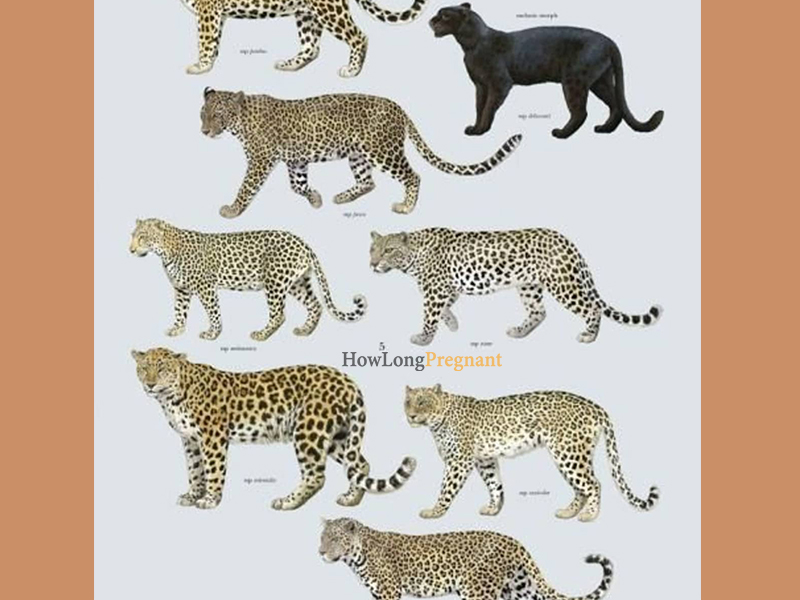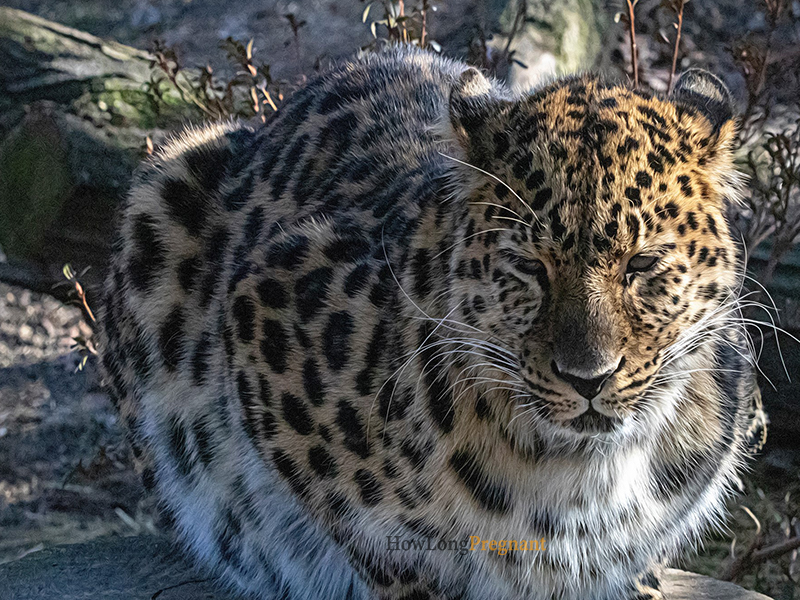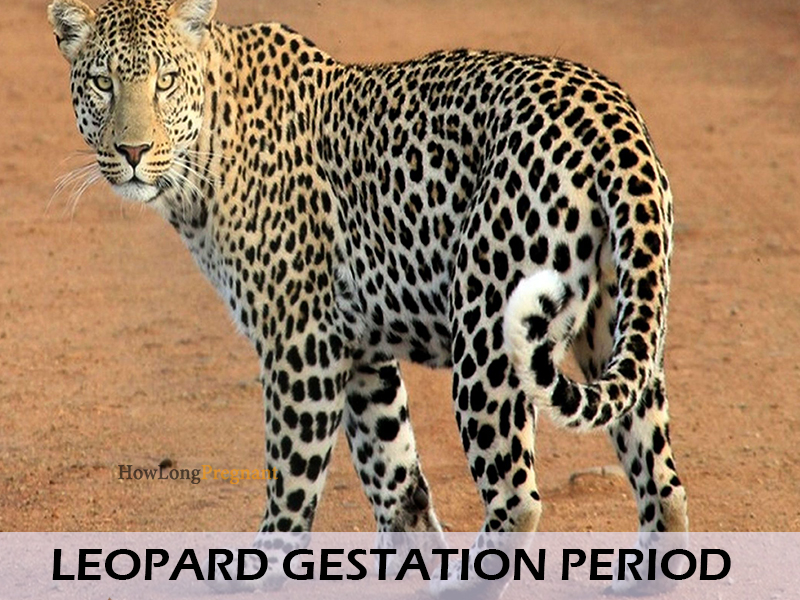Leopards, with their sleek coats and stealthy movements, embody the essence of elusive and enigmatic big cats, captivating our imagination through their presence in the wild. Yet, beyond their alluring exterior, lies a realm of leopard reproduction, a lesser-explored territory where the dance of life unfolds with intriguing twists and turns.
Within this narrative, the gestation period emerges as a key chapter, a time shrouded in mystery and profound significance. Lasting about 90 to 105 days, this period reveals the intricate complexities of life as female leopards navigate the delicate balance of survival and reproduction.
In this blog we will discuss about leopard gestation period and we will unravel the secrets and marvel at the silent spectacle that is the gestation period in the lives of these majestic creatures.
Gestation Period
The gestation period of a female leopard is a pivotal phase in the intricate cycle of life. Spanning approximately 90 to 105 days, this period serves as the canvas upon which the secrets of leopard motherhood are unveiled.
While relatively shorter compared to some other big cats, such as lions, this window is meticulously calibrated by nature to ensure the survival of the species. Within this temporal frame, the unseen alchemy of life takes place, as developing leopard cubs journey towards their entrance into the untamed world.
The brevity of this gestation period reflects the finely tuned adaptations of leopards to their environment, a testament to the delicate equilibrium they maintain in the relentless dance of survival and reproduction in the wild.
Different Types of Leopard and Their Gestation Period
There is one recognized species of leopard, Panthera pardus. However, leopards exhibit regional variations and subspecies due to their wide geographical distribution. Here are some subspecies of leopards with slight differences in their characteristics, although their gestation periods remain generally consistent:

African Leopard (Panthera pardus pardus): Gestation Period- Approximately 90 to 105 days.
Indian Leopard (Panthera pardus fusca): Gestation Period- Similar to the African leopard, approximately 90 to 105 days.
Sri Lankan Leopard (Panthera pardus kotiya): Gestation Period- Falls within the range of approximately 90 to 105 days.
Persian Leopard (Panthera pardus saxicolor): Gestation Period- Around 90 to 105 days.
Amur Leopard (Panthera pardus orientalis): Gestation Period- Approximately 90 to 105 days.
Basics of Leopard Reproduction
The basics of leopard reproduction unveil a captivating narrative as these solitary and enigmatic big cats traverse a complex journey marked by courtship rituals and the delicate intricacies of survival.
Unlike their social feline counterparts, leopards undertake this reproductive odyssey largely in solitude, adding an extra layer of intrigue to their tale. Their courtship rituals, often characterized by stealthy approaches and mesmerizing displays, showcase the unique adaptations that have evolved over generations.
Within the solitary realm they inhabit, leopards delicately navigate the fine balance between securing their lineage and surviving in the often harsh landscapes they call home. This solitary nature not only shapes their reproductive strategies but also contributes to the mystique that surrounds these majestic creatures in the untamed wilderness.
Environmental Influences
Leopard pregnancy is like a well-planned dance with nature, not just a simple countdown. As solitary hunters, leopards showcase a remarkable adaptability in synchronizing their reproductive schedules with the ever-changing conditions of their habitats.
This dance unfolds in harmony with the availability of prey, optimal weather patterns, and the delicate balance of the ecosystem they inhabit. Nature’s intricate design intricately orchestrates the timing of new leopard life, a testament to the profound connection between these majestic felines and the environments they navigate.
In this intricate ballet, leopards embody the essence of adaptability, ensuring the alignment of their reproductive rhythms with the rhythms of the wilderness, where the dance of life plays out against the backdrop of the untamed landscape.
Adaptations for Survival
Leopards, esteemed masters of adaptation, employ ingenious strategies to ensure the survival of their offspring. In a remarkable display of maternal instinct, female leopards carefully select concealed and secluded dens for giving birth, creating a secure environment for their vulnerable cubs during their initial weeks of life.
This strategic choice serves as a protective shield, minimizing the risk of predation and external threats, while offering a nurturing haven for the next generation to thrive.
The secluded den becomes a sanctuary where the intricacies of motherhood unfold, and the delicate balance between protecting the cubs and introducing them to the untamed world is delicately managed. Through these adaptive behaviors, leopards exemplify the art of safeguarding their lineage in the ever-changing landscapes they call home.

Unseen Ballet of Leopard Parenthood
The gestation period for leopards unfolds as a silent overture in the symphony of their lives- a time when the intricate rhythms of nature harmonize to orchestrate the arrival of new life. Amidst dense thickets, the expectant mother carefully selects covert dens, and her hushed footsteps echo the quiet anticipation that surrounds the unseen growth within her.
This clandestine process, hidden from the outside world, composes a mysterious melody of leopard gestation. The symphony encapsulates the delicate dance of life, where each note represents the culmination of nature’s orchestration—covert births, the nurturing embrace of secluded dens, and the unseen growth that heralds the future of the leopard lineage.
Also Read - Lions Gestation period and how long are Lions pregnant for?
FAQ
How do leopards adapt during gestation for the survival of their cubs?
Female leopards exhibit remarkable adaptations by choosing secluded and hidden dens for giving birth. This strategic choice minimizes the risk of predation and provides a secure environment for the vulnerable cubs during their early weeks.
How does environmental influence play a role in leopard gestation?
Leopard gestation is influenced by environmental factors such as an abundance of prey and optimal weather conditions. This dance with environmental influences showcases the adaptability of these solitary hunters in synchronizing their reproductive schedules with the changing conditions of their habitats.
What is the significance of the denning period in leopard reproduction?
The denning period, during the later stages of pregnancy, is crucial for female leopards as they seek out suitable dens to give birth and hibernate with their cubs. This period provides a safe and protected environment for the vulnerable cubs during their early months.
How do leopards master adaptation strategies for the survival of their offspring?
Leopards exhibit mastery of adaptation by choosing secluded dens for giving birth. This strategic choice minimizes the risk of predation and provides a secure environment for their vulnerable cubs during their early weeks, ensuring the survival of the next generation.
What role does the gestation period play in the broader context of leopard life?
The gestation period is a pivotal chapter in the broader context of leopard life, representing a time when the intricate rhythms of nature align to ensure the survival of the species. It serves as a silent symphony in the wild, orchestrating the arrival of new life through covert dens, hushed footsteps, and the unseen growth within, contributing to the thriving legacy of leopards in their untamed habitats.
How do leopards synchronize their reproductive schedules with favorable conditions?
As solitary hunters, leopards adapt their reproductive schedules to coincide with favorable conditions, such as an abundance of prey and optimal weather. This adaptability showcases their ability to synchronize their life cycles with the dynamic environment they inhabit.
Conclusion
As we peer into the shadows where leopards tread, the gestation period unfurls as a nuanced and essential chapter in their captivating narrative. It is a delicate dance with nature, a ballet of survival where each step is choreographed by the intricacies of life. The gestation period becomes an exploration of life’s delicate balance, a silent saga unfolding in the heart of the untamed wilderness. Behind the piercing eyes of a leopard lies a story of quiet anticipation, of covert births in secluded dens, and the unseen growth within.

